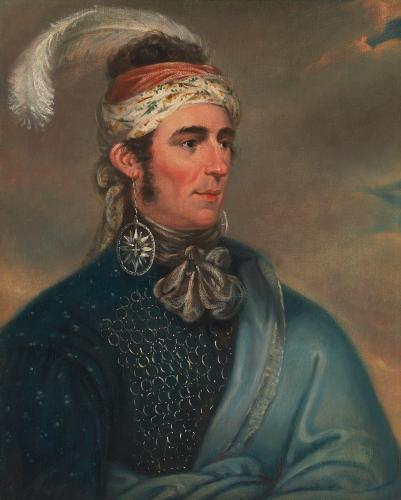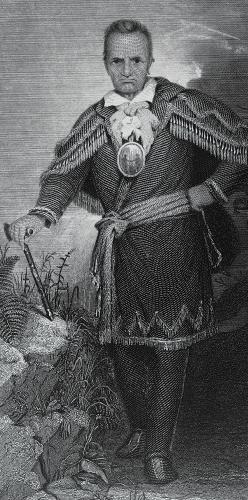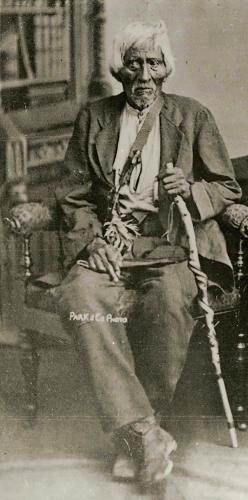“ As no quarrels are so bitter as those of families, so no wars are so cruel and passionate as those called civil.”
— Henry B. Dawson, Battles of the United States by Sea and Land, 1858
Imagine you had to choose sides in a fight between your oldest friend and his children who live next door. Remaining neutral is not an option. How would you decide which one to support? That is what the Six Nations Confederacy faced during the War of 1812.
The Confederacy was a union of Six Nations – Seneca, Cayuga, Onondaga, Oneida, Mohawk and Tuscarora – that had divided in 1776 over their allegiances to Great Britain and the American colonists. The chiefs refused to pick sides and left it up to each warrior to follow his heart. That fateful decision allowed the warriors to take up the hatchet and head down the war path of their own choosing.
Fathers and Sons
In 1777, that war path led them to a showdown at Oriskany, near fort Stanwix, where the Mohawk and Seneca allies of Great Britain found themselves in battle against their Oneida and Tuscarora relatives. Daniel Claus, who served as British Indian Agent, was at the battle, as was Sayenqueraghta (Old Smoke) and Gaiant’wake (Cornplanter), leading the British in an ambush over the Americans and their Oneida allies. It was one of the bloodiest encounters of the entire war. The legendary Great Peace of the haudenosaunee was shaken, and the Tree of Peace that had stood for centuries nearly fell to the ground.
“It was here that I saw the most dead bodies that I have ever seen. The bloodshed made a stream running down on the sloping ground,” recalled Seneca War Chief Tahwonneahs (Governor Blacksnake or Chainbreaker) about the battle.
Warriors under Thayendanegea (Joseph Brant) then raided and burned the Oneida settlement of Oriska, which caused the Oneidas to retaliate with a raid on the Mohawk castles of Tiononderoge and Canajoharie in the Mohawk Valley. Molly Brant, Joseph’s sister, was chased from her home. The burnt homes and crops from that era created a deep wound in the hearts of the survivors.
Few who survived that war could imagine that the same thing would take place a short 15 years later. This time, in the War of 1812, the children of the warriors who fought in the Revolutionary War would find themselves fighting each other. This time, Joseph Brant’s son Ahyouwaeghs (John Brant) was fighting alongside Daniel Claus’ son, Col. William Claus, who headed the same Indian Department that his father had done. Some of the same old war leaders, like Blacksnake, Cornplanter and Red Jacket, would take to the war path as well.
The Battle of Chippawa found Seneca, Cayuga and Onondaga warriors from the Buffalo Creek Reservation, near present-day Buffalo, N.Y., and other Seneca communities fighting their relatives from the Grand River Reserve in Ontario. The Tree of Peace was nearly toppled again.
Divided Loyalties
What was the powerful force that impelled the Haudenosaunee to set aside their tradition of peace and attack each other, despite the dire warning from the Great Peacemaker who had created their Confederacy many generations before? Simply put, different treaties, different wampum belts and divided loyalties tore apart the famed unity of the Great Law of Peace.
Since 1677 the Haudenosaunee had held a Covenant Chain Wampum belt that obligated them to protect their alliance with Great Britain and its colonies. Many times the British King shook that chain and asked the Haudenosaunee warriors to defend his interests, often leading to war against other Native nations. As France and Great Britain fought for dominance in North America, the Haudenosaunee were often caught in the middle. When Major-General Isaac Brock called for the Grand River warriors to defend the Crown in 1812, many felt obligated to act. They were still stinging from the losses of the Revolutionary War, and most of the people at Grand River had relocated there after the war because of their loyalty to the Crown, and the animosities their loyalty had created.
On the other hand, those who remained in their aboriginal homelands in New York made peace with the United States in 1784 and created a new Covenant Chain, manifested in the famous George Washington Covenant Belt. The new U.S. President pledged to protect Haudenosaunee land interests. As the Senecas explained prior to hostilities, they felt that they had no choice but to defend their land and ally with the Americans, who were so powerful they could crush the Seneca at will.
These two Covenant Chains – one that led to the King and the other to the President – tore nations apart in their loyalties. Wampum belts were part of a solemn treaty alliance that the Haudenosaunee took very seriously. Breaking those alliances could have major repercussions at that point in history. So, it is understandable that the different communities, with different allegiances, made the decisions they did. Despite the stern warnings of Red Jacket and the other Senecas prior to the war, the Grand River warriors wanted blood and could not be persuaded to remain neutral.
Pleas for Neutrality
With the war clouds growing on the horizon, Seneca leaders from Buffalo Creek visited with their relatives at Grand River and pleaded for neutrality in the upcoming fight. Red Jacket, also known as Sagoyewatha (He keeps them awake), had sent a special wampum belt to recall how the British had betrayed the Haudenosaunee in the last war, how the Americans were very powerful, and how war would only bring misery to the women, children and old people. These pleas fell on deaf ears.
John Norton, a Scots-Cherokee, had been adopted by Joseph Brant and had assumed a primary role as war leader. He was also known as Teyoninhokarawen. He was a devout Loyalist and told the Buffalo Creek leaders that the Grand River people had no choice and that their sense of honor and pride required them to fight on behalf of their great father, the King of England. He warned the Senecas to stay out of the way.
Once the war broke out, a second peace delegation met with the Grand River Chiefs, but the flames of war were too strong. Grand River declared that they now had a separate destiny from that of the Buffalo Creek people.
A third attempt by Tuscarora Chiefs sought assurance that if the Grand River warriors crossed the Niagara River they would not attack the Tuscaroras, who had remained neutral to that point. Once again, Grand River’s ears were not open to such talk, and their hearts were set on war. The Tuscarora Nation would feel the sting of war more than any other Haudenosaunee community.
Uneasy Allies
To make matters worse, both Great Britain and the Americans had uneasy feelings about involving the Native Nations as allies. They did not trust nor like the Haudenosaunee very much, but both the British and the Americans realised that Native allies were an absolute necessity. Better to have them by your side, than face them in the woods. However, the vision of Major-General Brock was to mobilize as many such allies as he could, because with the small number of British soldiers in Canada he could not fight a winnable war. He also did not trust the untrained militia or local citizens, many who were Americans recently arrived in Canada.
The Americans, on the other hand, pleaded with the Buffalo Creek leaders to have their warriors sit still, boasting that the U.S. would win this war quickly. They outnumbered the British by 10 to one. Yet, in the first few battles of the war, the British, due in large part to their Native allies, won decisive victories. In October of 1812, a small force of Grand River warriors, serving under John Norton and John Brant, were instrumental in holding off thousands of Americans at Queenston Heights until British reinforcements arrived and defeated the Americans. Dread of the Natives was so strong that Americans ran in fear, some jumping to their own death rather than face the wrath of the warriors.
In 1813, the war came to the Tuscarora and Seneca whether they wanted it or not. A British invasion of Seneca-held Grand Island in the Niagara River between Canada and the United States resulted in declaration of war by the Buffalo Creek leaders in June 1813. The British then invaded Black Rock, north of the Buffalo Creek Reservation. Seneca warriors helped to drive the British back across the water, fatally wounding a British officer. This seemed to incense the Grand River warriors and they declared that whatever neutrality that may have existed between them and the Seneca was over.
In December 1813, Mohawks from Grand River, along with Native warriors from the western allies (Anishinabec, Potowatamie and others) crossed the lower Niagara River and raided the town of Lewiston, capturing Fort Niagara and destroying the entire settlement of the Tuscarora Nation. Although Tuscarora warriors fought valiantly and held off a British advance, allowing many local whites to escape, yet they had to leave their homes to the torches of the British allies, many of whom were their Confederacy relatives from Grand River.
The British and Grand River warriors went on to burn the city of Buffalo. A Grand River Mohawk warrior named Sakayanwaraton (John Smoke Johnson), noted for his heroism under fire, was said to be the first one to torch the houses in Buffalo as the Seneca fled to the south.
July 5, 1814: Showdown at Chippawa
The United States responded in 1814 with another attempt to conquer Canada.
John Norton, scouting for the British, made a critical error in undercounting the invading American force. Some warriors serving under Norton were overzealous and sniped at the American forces, which withdrew and escaped Norton’s reconnaissance.
The British devised a battle plan based upon this inaccurate information. A planned surprise attack was uncovered by the Americans, and they struck first. British commander Brigadier General Phineas Riall also made a mistake. Only too late did he realise that the gray-coated solders opposing him were not militia, but were instead highly trained regular troops, who were not wearing their usual blue coats. Soon the British were in full retreat.
John Norton wrote in his journal about the events that took place at Chippawa, located on the western shore of the Niagara River opposite Navy Island and Grand Island. He led about 250 warriors from Grand River and was joined by 100 western warriors. As they advanced on the Americans, shooting into their tight formations, the Americans began to overwhelm the British down the line, and Norton suddenly heard the British bugle sound the retreat. Norton wrote that many of his warriors had disappeared and he had no choice but to “follow the example of our Brother warriors” and retreat.
Norton learned from a captured Seneca that the Americans were accompanied by 500 warriors from New York. Confusion reigned and the British were “routed with great loss.” Norton and his warriors were bogged down for two days. Then, Tecumseh’s brother Tenskwatawa, the Prophet, arrived with many warriors from the west. The high hopes of the Grand River warriors at the sight of these reinforcements were soon dashed by what took place.
Red Jacket, so named for sporting a bright red coat that he received from the British when they were his ally in the American Revolutionary War, led a force of several hundred warriors in that battle, and they were particularly vicious in their attack on the Grand River warriors. After the smoke cleared, the scope of the loss was staggering. British casualties included 148 dead, 321 wounded and 46 missing, while the Americans suffered 58 killed, 241 wounded and 19 missing. Over 80 men from Grand River lay on the ground, nearly 30 percent of the total force of warriors that entered the war. Things would never be the same.
Once more, Red Jacket stepped forward and proposed a mutual withdrawal from the war. His pre-war warnings had come true. We can only imagine what the surviving warriors thought of that defeat. Both sides seemed to be affected, and it was agreed that the majority of Haudenosaunee warriors would step down. John Norton, John Brant and John Smoke Johnson refused and continued to fight on to the end of the war. Some Buffalo Creek Senecas also kept up the fight until they won another victory at Fort Erie, and battles in the Niagara region came to an end. It is hard to image after the fierce fighting and devastation that things could ever be the same after the war.
The Reconciliation
Two councils were held at the end of the war in which the Haudenosaunee warriors and chiefs called upon their ancient traditions to heal the wounds of war. The war hatchet was ceremonially passed back to their allies, the weapons of war were buried under the Tree of Peace and the mutual friendship was re-established between the Grand River and Buffalo Creek Haudenosaunee.
Expressions of condolence were offered to wipe the tears of the warriors and their families. People were ritually cleansed to lift the grief and hatred they had felt as the result of the war. Tekarihoga, a principal Mohawk Chief and uncle to John Brant, spoke these words:
We the several Nations residing at the Grand River salute you from the other side. We are the same people with you, we are relations of the same colour, notwithstanding having been opposed to each other in the Field during the late Contest between our Father the King of England and the Americans…. The River which separates us is opened that we may have a free passage at all times. The roads are cleared of all briars and rubbish, that we may again renew that friendly intercourse which formerly existed between us. I now speak to you in behalf of the Indians residing on the Grand River, and I am desired to assure you that all ill will is removed from their Hearts towards you.
The Great Peace was restored once more. The once warring communities became dedicated to peace and have never fought among each other since that time.
The Aftermath
We often hear that to the victor belong the spoils of the enemy. In war, land is often a big part of the spoils. In the case of the War of 1812, land was the spoils coveted by both Great Britain and the United States. Great Britain tried to keep their pre-war promise of recovering the lands taken from the Native Nations in the Ohio Valley, but the U.S. would not hear of such. The Treaty of Ghent pledged to restore the rights, privileges and possessions held by the Native Nations prior to the war. However, within a generation after the war, the U.S. acquired 49,920 acres of land that was the Buffalo Creek Reservation. Most of the Haldimand Tract slipped through the hands of the Grand River people, a result of the duplicity of Col. William Claus, their wartime ally.
We may never agree on who won the war, but one thing is clear. You can win a war, but lose your honor. If you do not keep the sacred agreements of the Covenant Chain, and fail to live up to your pledges, what have you won? Perhaps we are now given a new chance to think, 200 years later, what does the honor of the Crown and the integrity of Congress mean in relation to their faithful allies and the long-standing land issues that have remained unresolved all this time. No matter what side my ancestors served on, our nations deserve justice for the sacrifices the warriors made. It is time to fulfill the pledges made so that all those Nations that fought in the War of 1812 can enjoy the bounty that peace has produced.



